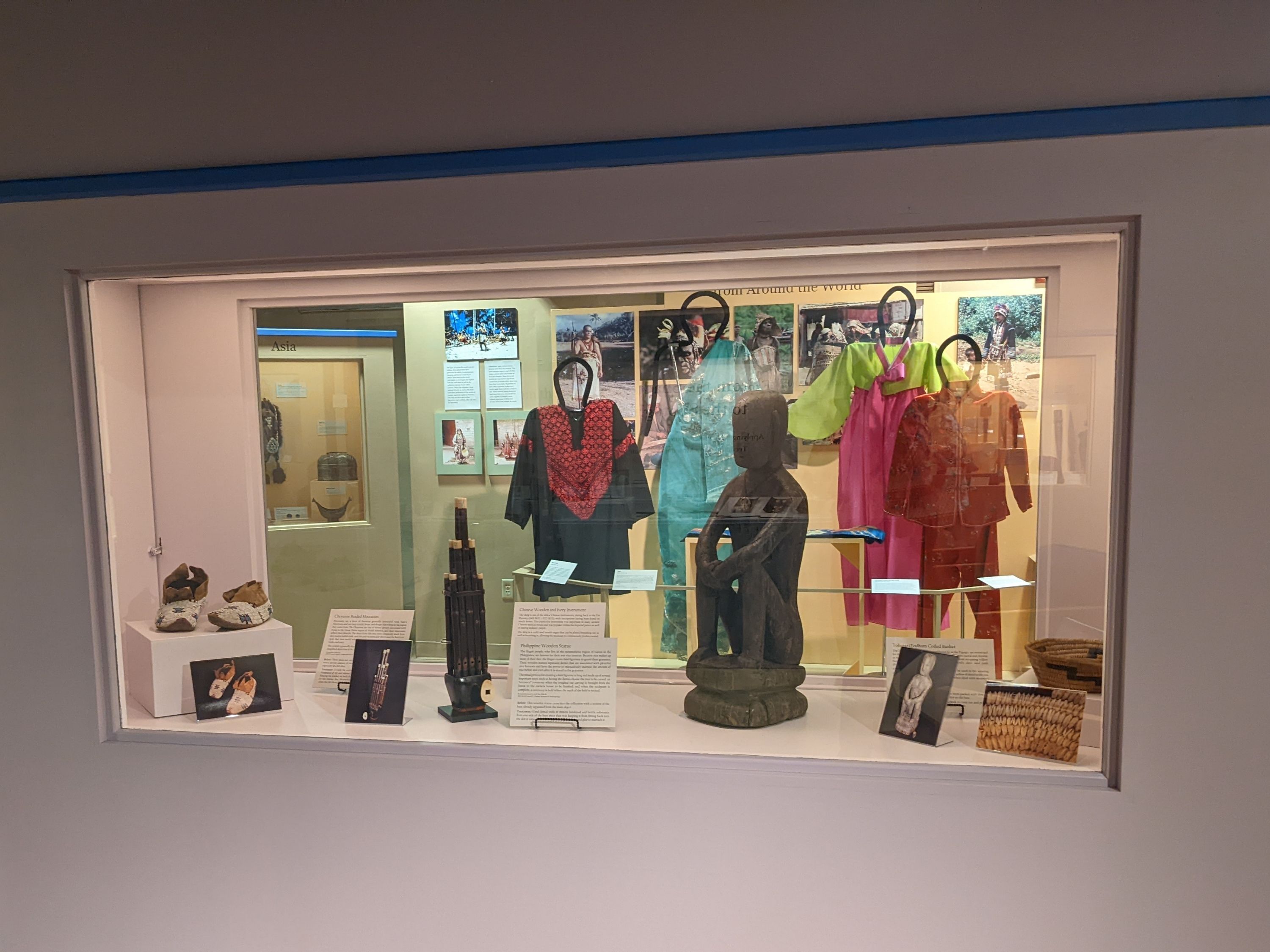From the Shadows to the Spotlight Case 2
Cheyenne Beaded Moccasins
Moccasins are a form of footwear generally associated with Native Americans and can vary in style, shape, and design depending on the region they come from. The Cheyenne are one of several groups associated with living in the Great Plains region of North America, and their moccasins reflect their lifestyle. The shoes from this area were commonly made from deer and/or buffalo hide, and this pair in particular showcases the hard sole style that was useful when traversing ground covered in prairie grass, rocks, and cacti.
The symbol repeatedly depicted on this pair of moccasins is, most likely, a simplified depiction of the universe and man's place in it.
Schemahorn Collection
1994.07.044a,b Lowell D. Holmes Museum of Anthropology
Before: These shoes not only had bent and folded ankle collars, but there was a decent amount of dirt covering the beads on the top of the shoes, especially the left shoe.
Treatment: To help the ankle collars stand up straighter, I used a slightly dampened Q-tip and dabbed at the creases to moisten the leather. After bracing the leather on both the inside of the shoe and the outside, I would let the leather dry. Meanwhile, I also used slightly dampened Q-tips to clean the dirt from the surface of the beads brighten the design.
Chinese Wooden and Ivory Instrument
The sheng is one of the oldest Chinese instruments, dating back to the Yin Dynasty (1401 BCE - 1122 BCE), with inscriptions having been found on oracle bones. This particular instrument was important in many ancient Chinese musical pieces and was popular within the imperial palace as well as among ordinary people.
The sheng is a multi-reed mouth organ that can be played breathing out as well as breathing in, allowing the musician to continuously produce sound. The bamboo pipes are of varying heights and are meant to represent the wings of a phoenix bird while at rest. Within the base, the pipes each have a metal reed that vibrates as air passes by it.
2008.11.001 Lowell D. Holmes Museum of Anthropology
Before: The old lacquer on the pipes was cracking and flaking in numerous places. Where it had completely worn off, the wood was dry and dull. There was also surface dirt at the base of all the pipes. Two pipes had, at some former time, lost their metal reeds and had been purposefully clogged with paper. Two other pipes had lost their reeds, which I located in the instrument base.
Treatment: Used Renaissance microcrystalline wax polish on all the wooden surfaces, being careful to avoid the ivory embellishments, in order to remove any surface dirt and create a protective layer over the wood and old lacquer. I then used a B-72 adhesive to reattach the two metal reeds to their respective pipes.
Philippine Wooden Statue
The Ifugao people, who live in the mountainous region of Luzon in the Philippines, are famous for their wet-rice terraces. Because rice makes up most of their diet, the Ifugao create bulul figurines to guard their granaries. These wooden statues represent deities that are associated with plentiful rice harvests and have the power to miraculously increase the amount of rice before and even after it is stored in the granaries.
The ritual process for creating a bulul figurine is long and made up of several important steps such as having the deities choose the tree to be carved, an "entrance" ceremony when the roughed out carving is brought from the forest to the owners house to be finished, and when the sculpture is complete, a ceremony is held where the myth of the bulul is recited.
Reverend Leonard A. and Mrs. Dale Sr.
2015.06.012 Lowell D. Holmes Museum of Anthropology
Before: This wooden statue came into the collection with a section of the base already separated from the main object.
Treatment: Used dental tools to remove hardened and brittle substance from one side of the base piece that was keeping it from fitting back into the slot it came from. Then applied Old Brown wood glue to reattach it.
Tohono O'odham Coiled Basket
The Tohono O'odham, sometimes referred to as the Papago, are renowned for their skill in creating baskets that were meant to be useful and durable as well as beautiful. Their coiled baskets are made from wrapping willow twigs in strips of yucca (Yucca eleta) and devil's claw seed pods (Proboscidea parviflora).
The yucca can be turned into different colors to be used in the weaving process: they turn green when dried in the shade, yellow if dried in the sun, white if dried in the sun with bleach, and red when dyed with simmered Spanish yucca root (Yucca arizonica).
Ashworth Collection
1988.09.001 Lowell D. Holmes Museum of Anthropology
Before: The interior crevices along the edges were packed with dust and dirt. There was also small amounts of loose dirt on the base.
Treatment: Used dental tools and Groom/Stick to coax out and pick up the dust and dirt from the crevices between plant fibers.
Return To Current Exhibits


